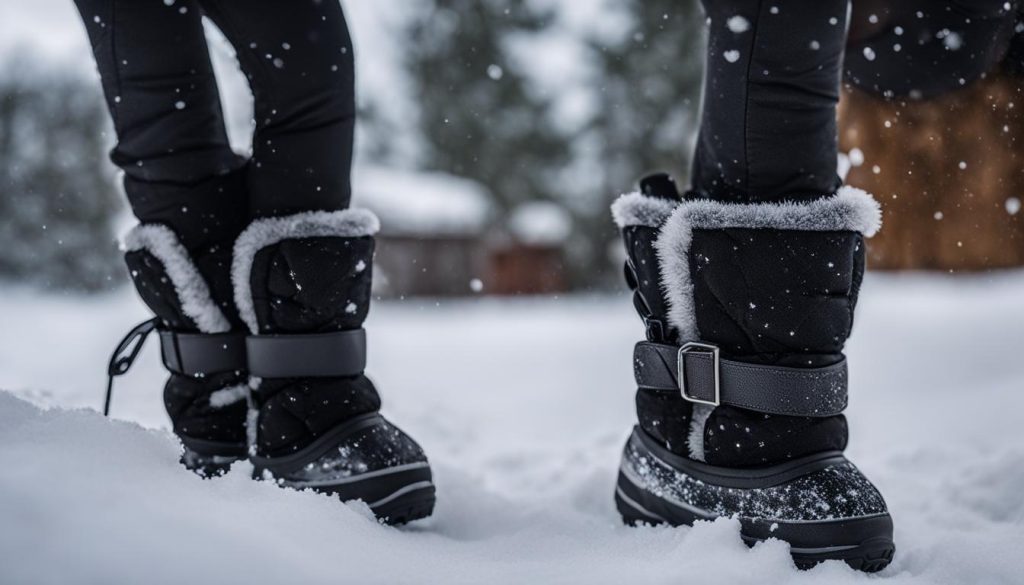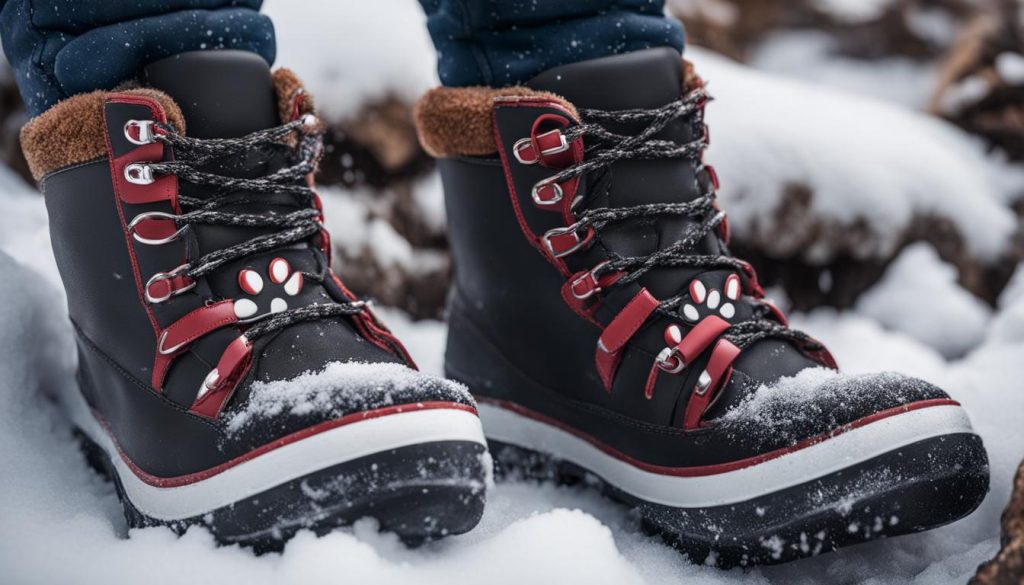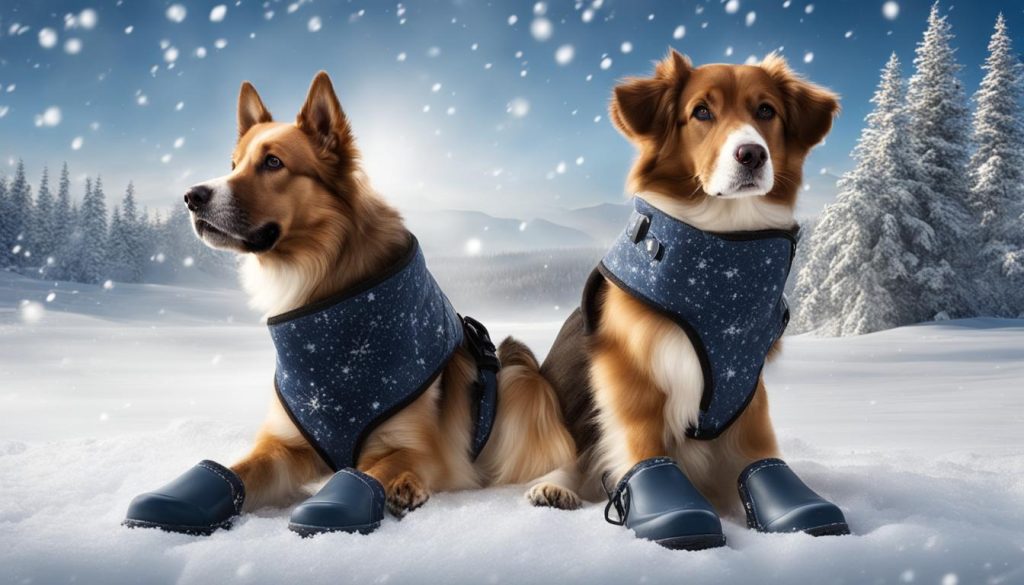Welcome to the ultimate guide to dog paw care. In this comprehensive guide, I will discuss the importance of protecting your dog’s paws, particularly during the winter months. Your dog’s paws are their main mode of transportation and require proper care to ensure their health and well-being.
During the winter, cold weather, ice, snow, and chemicals can all pose hazards to your dog’s paws. Cracked paws can be painful and lead to further complications if not addressed. That’s why I would advise that you take the necessary steps to protect your furry friend’s paw pad health.
One of the ways to protect your dog’s paws is by using paw balms or moisturizers. These products can help keep the paw pads hydrated and prevent them from drying out or cracking. Regular application of paw balm can help maintain the elasticity of the paw pads and provide an additional layer of protection.
Key Takeaways:
- Proper paw care is crucial for your dog’s overall health and well-being.
- Winter weather can be particularly harsh on your dog’s paws.
- Using paw balms or moisturizers can help prevent cracked paws.
- Regular application of paw balm is recommended for optimal paw pad health.
- Stay tuned for more tips on selecting the right winter boots and caring for them to protect your dog’s paws.
The Importance of Protecting Your Dog’s Paws in Winter
Winter weather can be tough on your furry companion’s paws. The cold temperatures can cause paw pad cracking and bleeding, making it painful for your dog to walk. Additionally, icy surfaces and sharp objects hidden under the snow pose a risk for injuries. To ensure your dog’s paws stay safe and healthy during the winter months, it is good practice to provide them with the necessary protection.
One effective way to protect your dog’s paws is by using winter dog boots. These boots offer a barrier between your dog’s paws and the cold ground, preventing frostbite and injuries. Winter boots also help to prevent the formation of snowballs between the paw pads, which can be uncomfortable and lead to discomfort or even hypothermia.
Investing in high-quality winter boots for your dog can provide peace of mind and keep them comfortable throughout the winter season. Look for boots that are specifically designed for cold weather and have non-slip soles to ensure stability on icy surfaces. Additionally, adjustable straps can help achieve a snug fit while allowing proper blood flow.
| Benefits of Winter Dog Boots | Features to Look For |
|---|---|
|
|
“Winter dog boots not only protect your dog’s paws, but they also provide added stability and comfort. They are a worthwhile investment to ensure your furry friend can safely enjoy outdoor activities during the winter season.” – Dr. Emily Thompson, Veterinarian
By prioritizing the protection of your dog’s paws in winter, you can prevent common paw injuries, discomfort, and potential health issues. Try to introduce your dog to their new boots gradually and use positive reinforcement techniques to help them adjust. Regularly check and clean the boots to ensure their effectiveness and to prevent any fungal growth. With the right winter dog boots and proper care, you can keep your beloved pet’s paws happy and healthy all winter long.

Dangers of Cold Weather to a Dog’s Paws
Prolonged exposure to cold surfaces can put your dog’s paw health at risk. Frostbite is a serious concern during winter months and can occur when the skin and tissues freeze due to extreme cold. It primarily affects the ears, tail, and paws of dogs. Frostbite can cause pain, swelling, and tissue damage, leading to long-term complications. Taking proactive measures, such as using protective boots, can significantly reduce the risk of frostbite and other cold weather-related paw issues.
Protective boots with a solid bottom provide better insulation and protection against the cold. The solid bottom design acts as a barrier, preventing direct contact with cold surfaces and reducing heat loss from your dog’s paws. These boots also protect against sharp objects hidden in the snow or ice, ensuring your dog’s paws stay safe and healthy. Additionally, they help to minimize contact with salt and de-icing chemicals used on sidewalks and roads, which can cause irritation and chemical burns on paw pads.
Investing in quality protective boots is essential, as they offer reliable protection against winter hazards. Look for boots with a snug fit and adjustable straps to ensure they stay securely on your dog’s paws. The boots should be comfortable and allow for natural movement without causing any restriction. Gradually introduce your dog to wearing boots and use positive reinforcement techniques to help them adjust. With the right boots and proper care, you can keep your furry companion’s paws in excellent condition throughout the winter season.

Snow and Ice Hazards to Dogs’ Paws
Winter brings with it snowy landscapes and icy conditions that can pose various hazards to your dog’s paws. I recommend that you be aware of these potential dangers and take steps to protect your furry friend. Let’s explore some of the common snow and ice hazards that can affect your dog’s paws.
Sharp Objects
When the ground is covered in snow, sharp objects like broken glass, nails, and even ice shards can be hidden from view. These objects can cause cuts, punctures, or abrasions on your dog’s sensitive paw pads. To mitigate this risk, please regularly check your dog’s paws for any signs of injury and promptly clean and treat any wounds.
Snowballs
Snowballs can form between your dog’s toes, especially if they have long hair or if the snow is particularly wet and sticky. These snowballs can cause discomfort and even lead to hypothermia if left unaddressed. Consider using dog boots with slip soles to prevent snow from accumulating between the paw pads. This will keep your dog’s paws dry and reduce the risk of snowball formation.
Slip Soles for Enhanced Paw Traction
The slippery nature of ice and packed snow can make it challenging for your dog to maintain traction while walking or running. This can result in accidental slips and falls, leading to paw injuries. Investing in dog boots with slip soles can provide the necessary grip and traction to prevent such accidents. These boots typically have textured soles that offer better grip on slippery surfaces, making it safer for your dog to navigate icy conditions.
| Sharp Objects | Snowballs | Slip Soles | |
|---|---|---|---|
| Impact | Potential cuts, punctures, and abrasions on paw pads | Discomfort and risk of hypothermia | Enhanced paw traction and reduced risk of slips and falls |
| Solution | Regularly check and clean paws Treat any wounds promptly |
Use boots with slip soles to prevent snow accumulation | Invest in dog boots with slip soles |
The Importance of Protecting Your Dog’s Paws in Winter
During the winter months, dogs are exposed to a variety of hazards that can cause harm to their paws. Cold weather, ice, snow, and chemicals used for de-icing can all lead to discomfort, injuries, and even chemical burns. I recommend for pet owners to take proactive measures to protect their furry friends’ paw pads and ensure their well-being.
Dangers of Chemicals: De-icing Salts and Antifreeze
De-icing salts used on roads and sidewalks can be a significant threat to your dog’s paw pads. These salts can cause chemical burns and irritation, leading to discomfort and potential long-term damage. Additionally, antifreeze, which is commonly used during the winter, is highly toxic if ingested by dogs. Protective dog shoes create a barrier between your dog’s paws and these harmful substances, reducing the risk of exposure and potential health problems. You should clean your dog’s paws thoroughly after walks to remove any residue from de-icing salts.
Furthermore, dogs often lick their paws to clean themselves, and if they have come into contact with de-icing salts or antifreeze, they may ingest these toxic substances. This can lead to severe poisoning and require immediate veterinary attention. Protective dog shoes not only protect your dog’s paws from external harm but also prevent them from licking and ingesting harmful chemicals.
Choosing the Right Protective Dog Shoes
When selecting protective dog shoes, it is essential to consider the quality of the materials and design. Look for shoes that have a durable construction to withstand winter conditions and provide maximum protection. The shoes should have a nonslip sole to prevent your dog from slipping on icy surfaces. Additionally, adjustable straps ensure a secure and comfortable fit.
You might want to introduce your dog to wearing protective shoes gradually. Start by allowing them to sniff and examine the shoes before putting them on. Reward them with treats and praise for their cooperation. Once your dog is comfortable wearing the shoes, take them on short walks to help them get used to the sensation.
| Benefits of Protective Dog Shoes | Drawbacks of Protective Dog Shoes |
|---|---|
|
|
Ultimately, protective dog shoes are a valuable investment in your dog’s paw health and overall well-being. By protecting their paws from the dangers of winter, you can ensure that your furry friend stays happy, healthy, and comfortable throughout the cold months.

Identifying the Right Winter Dog Boots
When it comes to protecting your dog’s paws during winter, selecting the right boots is crucial. Consider factors such as your dog’s size, breed characteristics, and the specific material and design of the boots. By taking these factors into account, you can ensure that your dog’s paws are adequately shielded from the harsh winter elements.
Firstly, take into consideration your dog’s size and breed. Larger breeds may require boots with sturdy construction to withstand their activity levels, while smaller breeds may need lighter and more flexible options. I recommend that you choose boots that fit comfortably without being too tight or too loose.
The material and design of the boots also play a significant role in their effectiveness. Look for boots with solid bottoms to provide insulation and protection against the cold ground. Non-slip soles are crucial to prevent accidents and ensure stability on icy surfaces. Additionally, opt for boots made from durable and water-resistant materials to withstand snow, slush, and moisture.
Factors to Consider when Selecting Winter Dog Boots:
- Size and breed characteristics of your dog
- Material and design for insulation and protection
- Solid bottoms for better insulation
- Non-slip soles for stability on icy surfaces
- Durable and water-resistant materials
Don’t forget that selecting the right winter dog boots is essential for your furry friend’s comfort and safety. Taking the time to find the perfect fit and suitable design will ensure that your dog’s paws stay protected throughout the winter season.

Comfort and Fit: Making Sure Your Pooch is Comfortable
When it comes to protecting your dog’s paws during winter, ensuring the comfort and fit of their boots is essential. Adjustable straps play a crucial role in achieving a snug fit without obstructing blood flow. A proper fit not only enhances your dog’s comfort but also increases the effectiveness of the boots in providing protection against cold, sharp objects, and chemicals.
Gradual introduction and positive reinforcement techniques can help your dog get used to wearing boots. Before putting the boots on, allow your dog to sniff and examine them. This familiarization process can alleviate any initial anxiety. Start by having your dog wear the boots for short periods, gradually increasing the duration as they become more comfortable.
Some dogs may take longer to adjust, but with patience and consistency, they can learn to appreciate the benefits of wearing boots. Try to reward your pup for their cooperation and positive behavior during the boot-wearing process. This positive reinforcement helps create a positive association with the boots and makes the training experience more enjoyable for both you and your dog.
Suggested Products for Comfortable Dog Boots:
| Product | Description | Price |
|---|---|---|
| Brand A | Adjustable straps for a customized fit | $XX.XX |
| Brand B | Padded interior for added comfort | $XX.XX |
| Brand C | Breathable mesh design to prevent overheating | $XX.XX |
Try to regularly check the fit of your dog’s boots. Adjust the straps as needed to maintain a secure but comfortable fit. Pay attention to any signs of discomfort, such as excessive rubbing or limping, and make necessary adjustments or consider trying a different brand or style of boots.
By prioritizing comfort and fit, you can ensure that your furry friend is ready to take on winter adventures without any discomfort or hindrance. Rest assured knowing that your dog’s paws are well-protected, allowing them to enjoy the season to the fullest.

Introducing Your Dog to Their New Boots
Gradually introducing your dog to wearing boots is essential to ensure their comfort and cooperation. By taking a slow and positive approach, you can help your furry friend adjust to this new experience and make wearing boots a positive and stress-free activity.
Start by allowing your dog to sniff and examine the boots. This will help them become familiar with the smell and texture, reducing any initial apprehension. Once they are comfortable with the boots, gently put them on one paw at a time, starting with short periods of wearing.
During the initial introduction phase, provide positive reinforcement. This can be done through praise, treats, or favorite toys to create positive associations with the boots. Gradually increase the duration of wearing, always monitoring your dog’s comfort level.

Training Techniques for Boot Introduction
- Positive reinforcement: Reward your dog with treats or praise when they show acceptance and cooperation with the boots.
- Take it slow: Don’t rush the process. Allow your dog to adjust at their own pace, gradually increasing the duration of wearing.
- Short practice sessions: Start with short periods of wearing and gradually increase the time. This will help prevent discomfort or resistance.
- Distraction technique: Engage your dog in a favorite activity while wearing the boots. This can help divert their attention and make the experience more enjoyable.
“By introducing dog boots gradually and using positive reinforcement, you can help your furry friend adapt to wearing boots and protect their paws during winter walks.” – Professional Dog Trainer
To put it simply, every dog is different, and some may take longer to adjust to wearing boots than others. Patience, consistency, and positive reinforcement are key. With proper training techniques and gradual introduction, your dog will soon become comfortable and confident wearing their new boots.
Ensuring the Boots Stay On
When it comes to protecting your dog’s paws, I would advise that you ensure that the boots stay securely on their feet. A secure fit is crucial to prevent the boots from slipping off during activities and compromising their effectiveness. Adjustable straps are a key feature to look for when selecting dog boots, as they allow for a personalized fit and can be tightened or loosened as needed.
In addition to adjustable straps, some dog boots also offer suspender systems that provide an extra layer of security. These suspender systems attach to the boots and connect to a harness or vest, keeping the boots securely in place even during high-energy play or vigorous exercise. They are particularly useful for dogs with a tendency to kick off their boots or for those who engage in activities that require a more secure fit.
I recommend that you pay attention to any signs of discomfort or irritation that your dog may exhibit while wearing boots. If the boots seem to be causing discomfort, it may be necessary to make adjustments to the straps or try a different style or size of boot. Try to always prioritize your dog’s comfort and ensure that the boots fit snugly without restricting blood flow or causing discomfort.
With a secure fit and proper fastening, dog boots can provide reliable protection for your furry friend’s paws, allowing them to enjoy outdoor activities in various weather conditions without worry. Whether you opt for adjustable straps or a suspender system, finding a solution that keeps the boots securely on your dog’s feet will help ensure their paw pads stay safe and sound.

Dog Boot Care and Maintenance
Proper care and maintenance of your dog’s boots are essential to ensure their effectiveness in protecting your furry friend’s paws. Regular cleaning, checking for damage, and proper storage will prolong the lifespan of the boots and keep them in optimal condition. Here are some tips for maintaining your dog’s boots:
Cleaning Dog Boots
After each use, clean your dog’s boots to remove dirt, debris, and any harmful substances they may have encountered. Use a mild soap or dog-specific boot cleaner and gently scrub the boots with a soft brush. Rinse them thoroughly to ensure no residue remains. Allow the boots to air dry completely before storing or reusing them.
Checking for Damage
Regularly inspect your dog’s boots for any signs of damage, such as tears, loose stitching, or worn-out soles. Damaged boots can compromise their effectiveness in protecting your dog’s paws. If you notice any damage, replace the boots promptly to ensure your dog’s safety and comfort.
Proper Storage
When not in use, store your dog’s boots in a cool, dry place away from direct sunlight. Excessive heat or moisture can damage the boots and decrease their lifespan. Consider using a designated storage bag or container to keep the boots clean and protected from dust and other contaminants.
By following these simple care and maintenance practices, you can ensure that your dog’s boots are always clean, in good condition, and ready to provide the necessary paw protection. Try to clean the boots after each use, check for any signs of damage regularly, and store them properly to maximize their lifespan.
Final Thoughts
Protecting your dog’s paws is of utmost importance in ensuring their health and well-being, especially during harsh winter conditions. Winter boots serve as a vital tool in safeguarding your furry friend’s paws from the cold, icy surfaces, sharp objects, and harmful chemicals.
By carefully selecting the right winter boots, considering factors such as your dog’s size, breed characteristics, and the materials and design of the boots, you can ensure optimal paw protection. Look for boots with solid bottoms, non-slip soles, and insulation to provide the necessary comfort and effectiveness.
Regular maintenance and care are crucial to maintaining the functionality of the boots. Clean them regularly to remove dirt, debris, and any harmful substances. Check for signs of damage and replace the boots as needed to ensure continued protection. Proper storage in a cool, dry place will prevent the growth of fungi and prolong their lifespan.
With proper dog paw care, including the use of winter boots and regular maintenance, you can keep your pup’s paws safe, comfortable, and healthy throughout the winter season. Ensure your furry companion’s well-being by protecting their paws and providing them with the necessary care and attention they deserve.
FAQ
Why is it important to protect my dog’s paws in winter?
Winter weather can be harsh on your dog’s paws, causing cracking, bleeding, injuries, and discomfort. Protecting their paws with winter boots can prevent these issues.
What are some of the hazards that cold weather poses to a dog’s paws?
Cold temperatures can lead to frostbite, paw pad cracking, and bleeding. Winter boots with insulation and solid bottoms can protect against these hazards.
How can snow and ice be harmful to my dog’s paws?
Snow and ice can hide sharp objects that can cut paw pads and cause injuries. Additionally, snowballs can form between the toes, causing discomfort and potential hypothermia.
Are there any chemicals that can harm my dog’s paws during winter?
De-icing salts used on roads and sidewalks and antifreeze can cause chemical burns on dog paw pads. You should protect their paws with dog shoes to prevent exposure to these substances.
How do I select the right winter dog boots?
When selecting winter dog boots, consider your dog’s size, breed characteristics, and the materials and design of the boots. Look for boots with solid bottoms, non-slip soles, and insulation for optimal protection.
How do I ensure that the boots fit my dog properly?
You should choose boots with adjustable straps to achieve a snug fit without restricting blood flow. Gradual introduction and positive reinforcement techniques can help your dog get used to wearing boots.
How can I introduce my dog to wearing boots?
You can introduce your dog to wearing boots by allowing them to sniff and examine the boots before putting them on. Start with short periods of wearing and reward them for their cooperation.
How can I ensure that the boots stay on during activities?
Proper fit and secure fastening of dog boots are crucial. Look for boots with adjustable straps and consider using a dog boot suspender system for added security. Pay attention to signs of discomfort and make necessary adjustments.
How should I clean and maintain my dog’s boots?
Regularly clean your dog’s boots to remove dirt, debris, and harmful substances. Check for any signs of damage and replace the boots as needed. Proper storage in a cool, dry place is recommended to prevent fungal growth.






